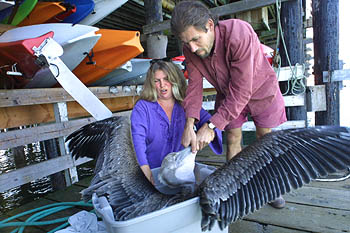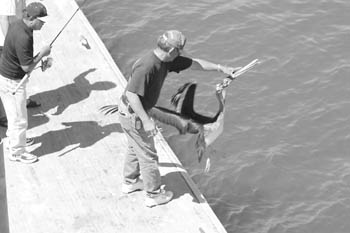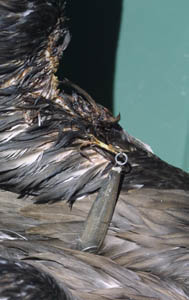![[Metroactive News&Issues]](/gifs/news468.gif)
[ Santa Cruz Week | Metroactive Central | Archives ]
Pelican't: Kymber Bonham (left) and a helper captured this hooked pelican at the kayak dock.
Pelican Grief
Competition between endangered brown pelicans and anglers reaches crisis level at the Santa Cruz Wharf
By Tai Moses
FRIDAY, AUG. 10, was the kind of day that Santa Cruz Wharf supervisor Dan Beucher calls "peak life in the bay." Fishermen crowded the railings of the wharf, their lines reaching to the water. Hundreds of brown pelicans, many juveniles on their first migration north from the Channel Islands, eagerly dove for the sardines and other baitfish that pods of sea lions had herded near the shore. Murres and cormorants joined the feeding frenzy. The shrieks of gulls mingled with the screams of tourists riding the Big Dipper at the Boardwalk.
Molly Richardson of Santa Cruz Native Animal Rescue has another expression for Aug. 10--she calls it "Black Friday." That day, NAR rescued 13 brown pelicans injured by fishing hooks or entangled in lines at the wharf--and those were just the birds so damaged they were unable to fly or swim away from rescuers.
In the weeks before and after Black Friday, an informal coalition of good Samaritans--NAR volunteers, employees of Venture Quest Kayaks and lifeguards--rescued pelican after pelican from the wharf, the Main Beach and Cowell's Beach. At last count, the number had climbed to nearly 200 birds.
The cause of this avian Waterloo is the presence at the wharf of a phenomenon fishermen call a "bait ball," a massive school of sardines and anchovies that is like a dinner bell going off in the ocean for man and beast alike.
"They're the popcorn of the sea," Beucher says of the sardines. "Everyone chases them: sea lions and salmon behind them, and the fishermen and the birds above them."
"If there's a school," says Paula Palattella, a Venture Quest employee who has rescued more than 40 pelicans at the wharf, "the pelicans are diving. And the fishermen go where the pelicans are, because they know where the fish are. So what happens is they go for the same fish. More often than not the pelicans are flying in to dive for their own fish, and they get caught, because there's 50 fishing lines in a 10-foot radius."
On Wednesday, Aug. 22, Santa Cruz Parks & Recreation Director Jim Lang authorized wharf personnel and lifeguards to post signs declaring 200 yards of the wharf off-limits to anglers. Native Animal Rescue had already put up its own warning signs, which the majority of anglers were ignoring.
Within days, however, most of the city's paper signs had blown off or been torn down, and the few that remained were having little impact. Pelican rescues were still taking place every day in the double digits. I saw one angler fishing right in front of one of the city's signs.
"I don't think it's current," he said, and gestured vaguely down the wharf: "I think it means no fishing over there."
Rescuers expressed frustration with what they considered the city's sluggish response to the problem. "There's not really anything in place to deal with anything like this," said Tricia Nelson, a wildlife specialist with NAR. "How bad does it have to get before any action is taken?"
Hook, Line and Sinker
CONSCIENTIOUS ANGLERS do pull up their lines when pelicans are feeding--or at least exercise caution. "Some of the techniques I've been noticing," said Kiet, a fishermen from San Jose angling on the wharf, "is, rather than casting overhead, [casting] underneath. I avoid pelicans that way. So far, it's been working for me."
"If you're a real fishermen, you're not going to cast into the birds," says Bob Strickland, president of United Anglers of California, a San Jose-based organization with 6,000 members. "Educated fishermen know better," he says.
But Beucher, who has worked on this wharf for 27 years, says less experienced fishermen are often more aggressive.
Bait fishermen on the wharf are a diverse group. "You have a language barrier out there," says Frank Ealy, owner of Santa Cruz Boat Rental and Capitola Boat and Bait.
One fisherman ratted out a fellow angler. "That guy caught three pelicans this morning."
Wharf construction worker Jon Bombaci says, "I think what's happened is we had large groups of people who come from places where wildlife isn't valued." He holds up a pencil popper, a shiny, tapered, 7-inch-long lure sporting two formidable triple-hooks. Surf-casters use it to catch stripers; that morning, a rescuer removed one just like it from a pelican's foot.
Tricia Nelson sees injuries in pelicans ranging from small holes to large infected necrotic wounds, and legs with circulation cut off by fishing monofilament for so long that the bird's feet are swollen and purple.
"The birds are often emaciated and hypothermic by the time we get them because they haven't been able to fish because of their injuries," she explains.
One hapless pelican, who became known to rescuers as #R78, had at least 10 fishhooks embedded in him. Many of the hooks came from anchovy jigs, lines that have six tiny barbed hooks designed to snag any part of a fish they touch.
One hook had worked its way deep into the crook of the pelican's wing, and the bird trembled as Sonia Rao of Venture Quest clipped the barbs and gently extracted the hooks from his body with a needle-nose pliers. A crowd of curious tourists gathered around. Cameras clicked. "Are you banding him?" an onlooker asked innocently.
After a brief stay at NAR's home rehab center, run by Molly Richardson and her two granddaughters, #R78 got a one-way ticket to the International Bird Rescue Research Center (IBRRC) in Suisun. There Santa Cruz's injured pelicans are rehabilitated and then released or, if their injuries are too severe, euthanized.
Reel Life: Nearly 200 brown pelicans injured by fishing hooks and lines have been rescued at the wharf this summer.
Fishing 101
THE BROWN PELICAN, ponderous on land, is a graceful acrobat in the air, perfectly designed for plunge-diving from heights as high as 60 feet and scooping up fish with its capacious dip-net bill. Air sacs beneath the bird's skin cushion the impact of the landings.
Just off the wharf, I watch a pelican hurtle in a steep, twisting dive toward the water. It hits with a neat splash and surfaces, its bill pointing upward to let the seawater drain out before it swallows its catch whole.
As the bird takes to the air again with slow, powerful wing beats, I see a 10-foot length of monofilament line trailing behind it, wrapped around the bird's foot.
Cutting the line after a pelican is hooked is one of the most disastrous mistakes a fisherman can make. Monofilament line entanglement is a slow, excruciating death for birds and other marine life. A casual glance around the wharf suggests that fishermen aren't doing a very good job of keeping tabs on this nasty stuff, which can last for 600 years in the saltwater environment. Fishing line can be seen dangling on wharf pilings, snarled on rocks and sticking out of trash cans, where gulls dig it out and become ensnared.
"People don't seem to have much knowledge that when fishing line gets wrapped around a pelican, it's a deadly situation," says Coleen Doucette, rehabilitation manager at the rescue center in Suisun. "They think when they cut the line and let the pelican go, all's well with the world, but that's not true.
"We need to educate the fishermen," she continues. "It's critical that when they're fishing they're not fishing in the same spot that the birds are."
Pelicans in Peril
O N FRIDAY, AUG. 31, the city finally acknowledged it needed help. The resources of Native Animal Rescue were overwhelmed. IBRRC was filled to capacity with Santa Cruz's maimed and mutilated pelicans.
The California Department of Fish & Game persuaded the city to extend its temporary closure up to Stagnaro's Bay Cruises, about three-quarters of the wharf. New bright-green laminated signs replaced the makeshift white pieces of paper.
"Due to unacceptable numbers of injuries to pelicans, this area is designated as Temporary No Fishing Zone, Municipal Code 9.66.050." (Fortunately. someone noticed that the code section quoted regulates ocean water sports and soon pasted it over with the marginally more appropriate Muni Code 13.04.011, which limits hours of operation.)
Next to the lifeguard's orange signs and NAR's yellow ones, the wharf looked pretty colorful. Even splashier were the bright fin flashes from the silver badges of uniformed Fish & Game wardens and city park rangers patrolling the wharf.
More than a few fishermen met the wharf closures with complaints.
"The wharf has been here for 90-something years, and it's been a fishing wharf and it's going to stay a fishing wharf," said Larry, a longtime wharf denizen who wouldn't give his last name. "The pelicans, they're the ones that are doing it, they're flying into the line. My opinion is I don't care about the pelicans. This has been a fisherman's wharf all along. Now a bunch of stupid birds come along, and they want to take over."
Over Labor Day weekend, Venture Questers and NAR rescued 42 pelicans: of those, 10 died. "Some of them, the injuries were so bad, the line was around the leg all the way to the bone," said Molly Richardson.
That weekend, NAR volunteer and avowed acrophobic Kymber Bonham pulled off a rescue that should have earned her a spot on Fox's Amazing Animal Rescues. Traversing the catwalk behind wharf restaurants, she climbed the narrow wooden ladder to the rooftops where about 100 pelicans were roosting, among them numerous birds with old wounds and one dead bird. The pelican she was pursuing had a gaping bloody hole in its chest, but it flapped weakly away at her approach. She succeeded in capturing one pelican, and, holding the bird with its bill tucked under one arm, she descended the ladder one hand at a time, resting her weight on a finger while she stepped from rung to rung.
Photograph by George Sakkestad
Protection Racket
THE CALIFORNIA brown pelican has been listed as a federally endangered species since 1970 (under a law that preceded the Endan gered Species Act of 1973) and has been protected under the California Endangered Species Act since 1971. Pelicans are also protected under the Migratory Bird Act.
That makes it sound as if a battalion of agencies is looking out for the brown pelican, and indeed, there are substantial fines for anyone caught intentionally harming one of the seabirds. The Endangered Species Act clearly states that any "take" of a listed species is illegal; technically, "take" includes any activity that interferes with an endangered bird's ability to feed.
According to Michael J. Bean, an attorney with Environmental Defense who specializes in endangered-species law, "The accidental hooking of a brown pelican is a violation of the Endangered Species Act; it clearly represents the taking of a pelican."
Bean says, however, that the U.S. Fish & Wildlife Service prosecutes very few violations of the ESA, particularly in cases where there is no clear intent to harm the bird.
"I suspect that Fish & Wildlife is inclined to look the other way on problems like this and probably will continue to do so unless it feels some substantial pressure," Bean said.
"We are concerned about that accidental source of mortality of the brown pelicans," Lois Grunwald, spokesperson for U.S. Fish & Wildlife told me. "But at this point, we have no programs to specifically address the hooking of the birds. We've only got so much manpower, and we have to focus our manpower on serious, egregious cases."
Frank Spear, chief of marine patrol for the California Department of Fish & Game, says his agency intends to educate fishermen and encourage voluntary compliance with the temporary fishing ban, not to issue citations.
"Our goal is to reduce the injuries to the brown pelican," Spear said. "We want to keep the pier open for fishing, but we want to give the pelicans a little more room. We're trying to work it out for pelicans and people."
What remains unclear to many observers is why it took so long for the city to contact Fish & Game in the first place. Native Animal Rescue was stretched to capacity rescuing and caring for birds, and the city seemed to be crossing its fingers that its partial closure would do the job.
"We're looking at this on a day-to-day basis," said Parks & Rec Director Lang. "We had really hoped the baitfish were moving out."
"It took a while for the city to say this is not an acceptable level [of pelican injuries], when in fact there is no acceptable level," said Richard Mark, president of NAR.
"One of the things we were kind of surprised at is the loss [of pelican life] before anyone called us," Frank Spear said. "We were down there the day after we heard of it."
Pass the Bait
AS THE FIRST WEEK of September draws to a close, there are signs that the worst is over. New pelican hookings have dramatically declined, but rescuers are still finding birds debilitated by old wounds.
At an interagency meeting called by NAR on Sept. 5, the predicament was thrashed out from all angles. To drive home its point, NAR had brought along a carload of pelican carcasses, all wharf fatalities, which members piled in a heap outside the meeting room at the Yacht Harbor. The faint stench of the dead birds wafted in through the open door as people spoke.
"I just hate to see this kind of carnage, but I hate to see the fisherman lose too," said Bob Strickland.
"The majority of fishermen are certainly not out to snag the birds, but they have the right to fish from a public facility," said another fisherman.
Gathered in the room were members of conservation and animal-rescue groups, birders, biologists, fishermen, wharf business owners and Fish & Game wardens. Wharf officials, who work under Parks & Rec, were also present. Conspicuously absent from the meeting was the City of Santa Cruz, the decision-making body for wharf policy.
A meeting that began with clashes between defensive fishermen and exhausted pelican rescuers was ultimately a surprising example of how people with seemingly conflicting interests can work together. No one wanted any more pelicans to be hurt, neither did anyone want to see fishing permanently banned on the wharf. At the top of the wish list was a contingency plan in case the situation reoccurs next summer.
The other critical issue is the cost of the emergency. The short-term local care that pelicans receive at NAR costs about $30 per bird. Longer-term rehab at IBRRC is $100 a bird. This summer, IBRRC had to get a $15,000 bailout loan from the International Fund for Animal Welfare to pay for the 175 pelican casualties that came from Santa Cruz. IBRRC director Jay Holcomb issued a statement demanding that the U.S. Fish & Wildlife Service step in to protect the pelicans and that the city of Santa Cruz "acknowledge that the Endangered Species Act takes precedence over recreational fishing for baitfish."
For its part, Fish & Game appears highly motivated to enact new regulations that will protect the pelicans and still allow fishing off the wharf. "The take [of pelicans] is becoming unreasonable," Spear declared.
Among the solutions brainstormed were modification of fishing gear; rotating closures on the wharf; aerators to move the bait away from the wharf; and public education for fishermen. Whatever happens on the Santa Cruz Wharf will be a test case for other municipal fishing piers in California.
Contemplating the rebounding pelican population, abundant sardines and growing numbers of fishermen, wharf supe Dan Beucher waxes philosophical.
"Too many living creatures all in the same spot," he says ruefully. "It's the future."
Copyright © Metro Publishing Inc. Maintained by Boulevards New Media.
![]()

Photograph by George Sakkestad

Photograph by George Sakkestad
 Fatal Attraction: Left in a pelican, even a single fishhook can become infected and permanently cripple or kill the bird. Hooks and lines are the major causes of mortality among California brown pelicans.
Fatal Attraction: Left in a pelican, even a single fishhook can become infected and permanently cripple or kill the bird. Hooks and lines are the major causes of mortality among California brown pelicans.
From the September 12-19, 2001 issue of Metro Santa Cruz.